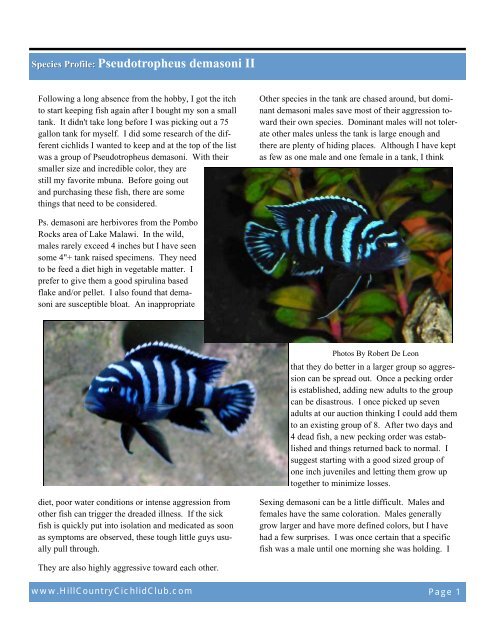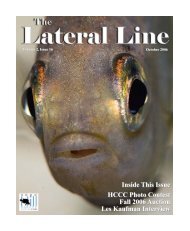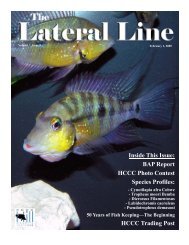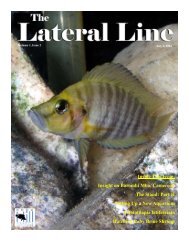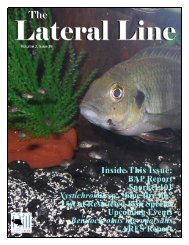Pseudotropheus demasoni 2.pub - Hill Country Cichlid Club
Pseudotropheus demasoni 2.pub - Hill Country Cichlid Club
Pseudotropheus demasoni 2.pub - Hill Country Cichlid Club
You also want an ePaper? Increase the reach of your titles
YUMPU automatically turns print PDFs into web optimized ePapers that Google loves.
Species Profile: <strong>Pseudotropheus</strong> <strong>demasoni</strong> IIFollowing a long absence from the hobby, I got the itchto start keeping fish again after I bought my son a smalltank. It didn't take long before I was picking out a 75gallon tank for myself. I did some research of the differentcichlids I wanted to keep and at the top of the listwas a group of <strong>Pseudotropheus</strong> <strong>demasoni</strong>. With theirsmaller size and incredible color, they arestill my favorite mbuna. Before going outand purchasing these fish, there are somethings that need to be considered.Other species in the tank are chased around, but dominant<strong>demasoni</strong> males save most of their aggression towardtheir own species. Dominant males will not tolerateother males unless the tank is large enough andthere are plenty of hiding places. Although I have keptas few as one male and one female in a tank, I thinkPs. <strong>demasoni</strong> are herbivores from the PomboRocks area of Lake Malawi. In the wild,males rarely exceed 4 inches but I have seensome 4"+ tank raised specimens. They needto be feed a diet high in vegetable matter. Iprefer to give them a good spirulina basedflake and/or pellet. I also found that <strong>demasoni</strong>are susceptible bloat. An inappropriatePhotos By Robert De Leonthat they do better in a larger group so aggressioncan be spread out. Once a pecking orderis established, adding new adults to the groupcan be disastrous. I once picked up sevenadults at our auction thinking I could add themto an existing group of 8. After two days and4 dead fish, a new pecking order was establishedand things returned back to normal. Isuggest starting with a good sized group ofone inch juveniles and letting them grow uptogether to minimize losses.diet, poor water conditions or intense aggression fromother fish can trigger the dreaded illness. If the sickfish is quickly put into isolation and medicated as soonas symptoms are observed, these tough little guys usuallypull through.Sexing <strong>demasoni</strong> can be a little difficult. Males andfemales have the same coloration. Males generallygrow larger and have more defined colors, but I havehad a few surprises. I was once certain that a specificfish was a male until one morning she was holding. IThey are also highly aggressive toward each other.www.<strong>Hill</strong><strong>Country</strong><strong>Cichlid</strong><strong>Club</strong>.com Page 1
Species Profile: <strong>Pseudotropheus</strong> <strong>demasoni</strong> IIam not sure as to how long females hold, but I'm guessinganywhere between 3 to 4 weeks. In a large group, itis difficult to differentiate between the different holdingfemales, making it almost impossible to keep track ofwhich one is which and how long they've been holding.I've found that once their mouths look like they areabout to pop and their chin is dark black, its time to fishthem out and strip them. I've had broods as small as sixHolding Female—Photo By Robert De Leonand as large 15. Fry have the same blue and black colorsas the parents. They eagerly accept crushed flakeand grow quickly.After years of keeping <strong>demasoni</strong>, I had never seen themspawn. One day I saw the oddest thing. My dominantmale and a female were circling each other on the backglass. I kept watching and noticed the most amazingthing. They were spawning on the calcium and algaeencrusted back glass. The female was sticking the eggsto the back glass and quickly turning around and pickingthem up. She would then follow the male presumablyto fertilize the eggs. I don't know if the eggs weresticky or it was the rough texture of the back glass thatwas holding the eggs after they were dropped.to a hiding place for the next couple weeks. I've foundthat other <strong>demasoni</strong> will target the holding females but Ihave never found the aggression to be too persistent.Catching holding females can be a chore as it is easy toconfuse them for the other fish in the tank. Once the fryare stripped from the female, I've noticed that they makeno effort to try to put them back in their mouths. WhenI've let the females release in a small tank by themselves,they don't show any post-release care for thefry. Like I mentioned earlier, the fry grow quicklyand it doesn't take long before they start chasing eachother, presumably practicing for when they mature.Ps. <strong>demasoni</strong> make good additions to tanks wheretheir proper diet can be maintained. Other species offish in the tank must also be able to hold their own orthe <strong>demasoni</strong> will walk all over them. Demasonispend most of their time hugging the rocks and substrateand usually never swim into open water unlessit's feeding time. Nonetheless they are highly active,constantly moving in and out of cover and chasingeach other around. I would recommend keeping themwith other mbuna but I have also had success keepingthem with Victorian cichlids, although the Victoriansare noticeably intimidated by the <strong>demasoni</strong> resultingin poor color.— by Robert De LeonOnce the spawning is over, the females usually retreatwww.<strong>Hill</strong><strong>Country</strong><strong>Cichlid</strong><strong>Club</strong>.com Page 2


